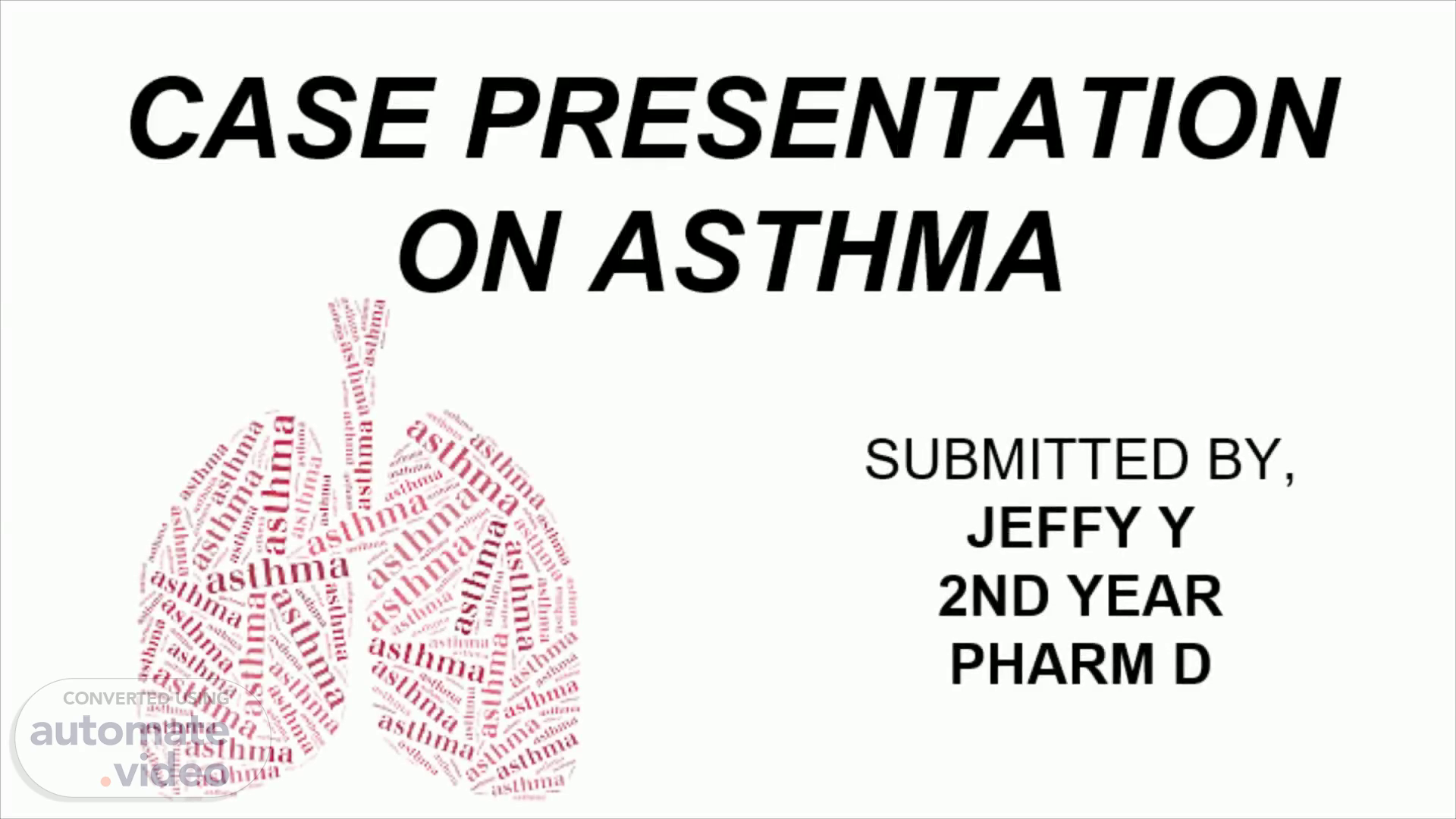
CASE PRESENTATION ON ASTHMA
Scene 1 (0s)
CASE PRESENTATION ON ASTHMA. SUBMITTED BY, JEFFY Y 2ND YEAR PHARM D.
Scene 2 (8s)
PATIENT DETAILS. Name: ABC Age: 30 Years Sex: Female IP no: 48105 Dept: GENERAL MEDICINE.
Scene 3 (17s)
SUBJECTIVE EVIDENCE. Reason for the admission: c/o Difficulty in breathing , wheezing and cough with sputum since 2 days c/o fever since 2 days Past medical history: NIL Past medication history: NIL SOCIAL HISTORY: NIL FAMILY HISTORY: Mother is having h/o Asthma..
Scene 4 (33s)
OBJECTIVE EVIDENCE. GENERAL EXAMINATION: Pallor: Negative Icterus: Negative Cyanosis: Negative Clubbing: Negative Lymphadenopathy : Negative Edema: Negative.
Scene 5 (44s)
OBJECTIVE EVIDENCE. PHYSICAL EXAMINATION. DATE D1 D2 D3 D4 TEMP. 101.2 99.5 98.5 98.5 BP 100/70 110/90 120/80 110/80 PULSE RATE 84 80 7 8 73.
Scene 6 (1m 0s)
OBJECTIVE EVIDENCE. BLOOD INVESTIGATIONS. PARAMETER OBSERVED VALUE NORMAL VALUE HB 12.3 12-16g/d l PLT 2.5 1-3 lakhs TLC 5900 5000-10000 BASOPHILS 0 0-1 POLYMORPHS 76 40-60 LYMPHOCYTE 25 20-30 EOSINOPHILS 3 1-4 MONOCYTES 4 2-10.
Scene 7 (1m 15s)
OBJECTIVE EVIDENCE. URINE EXAMINATION. PARAMETER OBSERVED VALUE Colour Pale Yellow Bile salts Nil Bile Pigments Nil Albumin Nil Pus cells 1-3 Sugar - Epithelial cells 2-3.
Scene 8 (1m 26s)
OBJECTIVE EVIDENCE. OTHER EXAMINATION Chest X-ray : Left side chest consolidation present..
Scene 9 (1m 34s)
ASSESSMENT. DIAGNOSIS: By Subjective evidences like Difficulty in breathing , wheezing and cough with sputum, fever and Objective evidences like increased levels of polymorphs and from chest X-ray, the patient was diagnosed with “ ACUTE EXACERBATION OF BRONCHIAL ASTHMA ”.
Scene 10 (1m 49s)
PLAN. Goals of treatment : - To reduce the symptoms. To avoid the complications of the disease. To avoid the exposure to the triggering factor. To reduce inflammation and to increase bronchodilation..
Scene 11 (2m 1s)
TREATMENT CHART. S.NO TRADE NAME GENERIC NAME DOSE FREQUENCY DAYS OF TREATMENT D1 D2 D3 D4 D5 D6 1. Nasal Oxygen - 2 ltr per min Until SpO2 reaches more than 95 % at room air / - - - - - 2. Tab. Dolo Paracetamol 650 mg 1-0-1 / / sos - - - 3. Tab. Zantac Ranitidine 150 mg 1-0-1 / / / / / - 4. syp.Ascoril Terbutaline 2 tsp 1-1-1 / / / / / / 5. Cap. Amox Amoxicillin 250 mg 1-0-0 / / / / / - 6. Neb. Asthalin Salbutamol 100 mg 6 hourly / / / - - - 7. Neb. Duolin Levosalbutamol + Ipratropium (1.25mg)+(500mcg) Thrice a day / / / / / / 8. Neb. Budecort Budesonide 0.5mg Thrice a day / / / / / /.
Scene 12 (2m 36s)
GOALS ACHIEVED. Breathlessness and fever has reduced. The patient condition has been improved..
Scene 13 (2m 45s)
PHARMACIST INTERVENTION ( PATIENT COUNSELING). SUGGESTION TO PATIENTS Diet Eat plenty of fruits and vegetables Avoid allergy triggering foods like shellfish, diary products, processed food, peanuts. Take food rich in vitamin C like citrus fruit and vitamin E rich food. Take in vitamin D. People with more-severe asthma may have low vitamin D levels. Milk, eggs and fish such as salmon all contain vitamin D. Even spending a few minutes outdoors in the sun can increase vitamin D levels..
Scene 14 (3m 7s)
PHARMACIST INTERVENTION. Lifestyle modification Like any chronic illness patients, the asthma patients should adopt certain lifestyle modifications.These lifestyle modifications are mentioned below : Avoid exposure to smoke. Keep your house especially the bedroom, clean and dust free. Wear a dust mask. Do regular breathing exercises. Try to keep windows closed during allergy season. Avoiding asthma triggers like house dust, mites, pollens grains..
Scene 15 (3m 27s)
PHARMACIST INTERVENTION. Counselling related to Drugs Avoid OTC medications as some OTC medications can increase the risk of getting an asthma attack. Avoid OTC drugs like Aspirin, Indomethacin, Ibuprofen, Naproxen, etc during pregnancy. While counselling the patient the pharmacist can use placebo inhalers so that it becomes easy to demonstrate to the patient. Terbutaline Take this medication by mouth with or without food, usually 3 times daily or as directed by your doctor. Dosage is based on your medical condition and response to therapy..
Scene 16 (3m 51s)
THANK YOU.